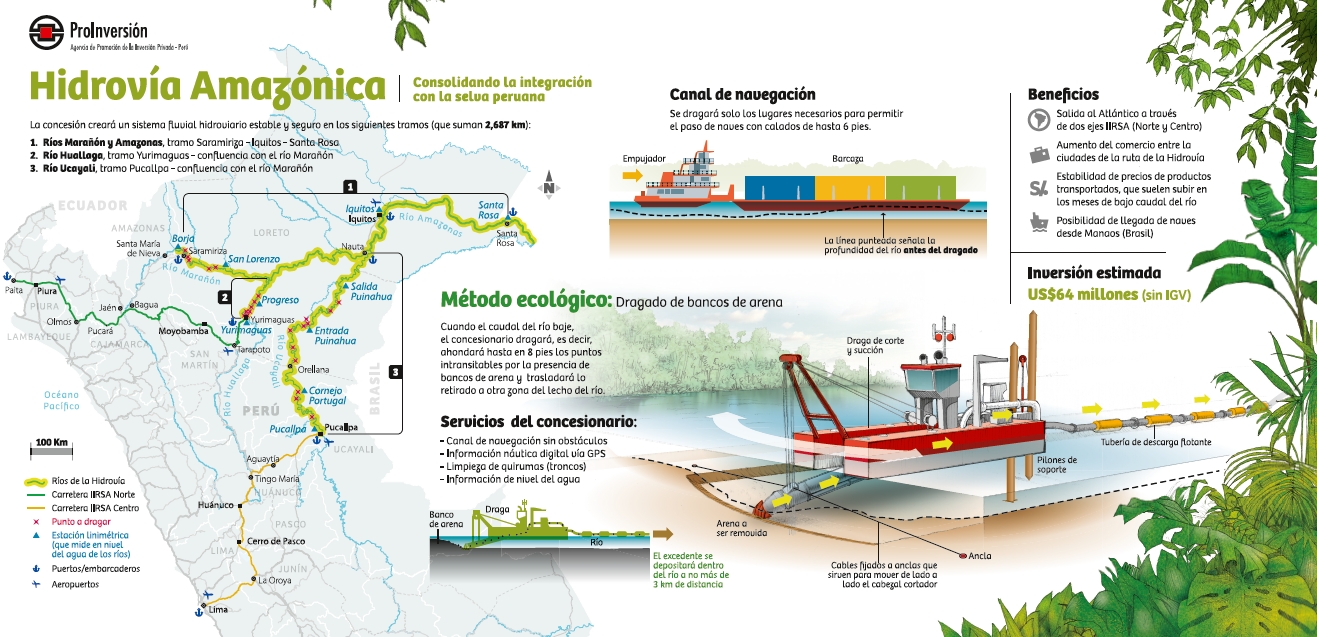Protecting the Peruvian Amazon: Indigenous groups fight bad environmental impact assessments
By: Sharon Khan

In northern Peru, a proposed massive project to dredge Peru’s four most critical Amazonian rivers, the Marañón, Ucayali, Huallaga, and Amazon, is threatening the health of aquatic ecosystems and the way of life for more than 40,000 indigenous people.
The Hidrovía Amazónica has been promised to create a modern waterway to make river transportation faster and more efficient. Ultimately, the hidrovía, a man-made waterway that is navigable for travel and transport of merchandise, will connect Brazilian markets to Pacific ports.

However, local NGOs have found that when superimposing the map of the waterway on the map of the official fishing zones, the overlap is overwhelming, with at least 1,000 recognized fishing spots along the 2,687 kilometers of the hidrovía.
Those same NGOs, like DAR and AIDESEP, have voiced their concerns that environmental impacts have not been addressed transparently and thoroughly, and that consultation with the local indigenous communities has been negligent. In March 2019, in a precedent-setting decision reported by MONGABAY, the National Service for Environmental Certification for Sustainable Investments denied the environmental impact assessment (EIA) for the project, as it was submitted before the consultations with indigenous groups were completed. Now the company, COHIDRO, can either present a complete environmental impact assessment or appeal the decision.
“Un estudio mal hecho podría no reconocer todos los impactos y las medidas de mitigación necesarias para garantizar el derecho a la vida, la salud, la alimentación, y a un ambiente sano de los pueblos indígenas que convivirán con el proyecto. […] Nosotros, mejor que nadie, sabemos qué impactos nos pueden afectar. La voz no solo es de consulta, nuestra voz es ahora determinante y debe ser escuchada en este proceso.” — Jorge Perez, presidente de ORPIO
“A poorly done study may not recognize all the impacts and mitigation measures necessary to guarantee the right to life, health, food, and a healthy environment of the indigenous peoples that will coexist with the project. […] We, better than anyone, know what impacts can affect us. The voice is not only for consultation, our voice is now decisive and should be heard in this process. ” — Jorge Perez, president of ORPIO
Leaders of some of the local grassroots NGOs, including those noted above, whose advocacy resulted in the decision to deny the EIA, joined me at a Waterkeeper Alliance workshop about strengthening civil society participation in decision-making processes around water infrastructure projects in Perú’s Marañón river basin and key portions of the Ucayali, Huallaga, and Amazon Rivers. The workshop was held on April 25, 2019, in Cartagena, Colombia, alongside the Waterkeeper Alliance Latin America Regional Summit. There, 22 Waterkeeper groups from the region met for strategic training. Peru’s Marañón River Waterkeeper—who is successfully fighting inadequate environmental impact assessments for two large hydroelectric dam projects on the upper Marañón River—is a key participant.
Waterkeeper Alliance is no stranger to bad environmental impact assessments and accompanying cost-benefit analyses. In fact, I was first hired by Waterkeeper Alliance in 2005 to assist Waterkeeper groups around the world in fighting them by highlighting the valuable social, cultural, and ecosystem benefits of watershed protection—using the best defensible science and data.
Using this strategy, Miami Waterkeeper and partners recently forced the U.S. Army Corps of Engineers to delay a dredging project to expand Port Everglades, north of Miami, to make way for larger, “post-Panamax” shipping vessels. The project has been delayed by three years so that environmental reviews can be more substantially completed. Prior to this win, Miami Waterkeeper won a settlement with the U.S. Army Corps of Engineers to restore 10,000 federally protected staghorn corals damaged during the dredging of the Port of Miami. These corals provide extensive public benefits, like fish habitat and coastal storm surge protection.
“The Corps’ and [National Marine Fisheries Service’s] prior environmental analyses simply ignored evidence from Port Miami that showed estimated impacts from dredging near corals are significantly more harmful and widespread than expected. The current environmental impact statements do not reflect best available science.” — Rachel Silverstein, Miami Waterkeeper
As members of our global network, Marañón River Waterkeeper, Miami Waterkeeper, and other Waterkeeper groups around the world share strategies and lessons learned to fight common threats to their watersheds. Waterkeeper Alliance looks forward to working with the indigenous groups fighting the Hidrovía Amazónica to protect Peru’s most invaluable rivers.
Feature image of the Marañón River